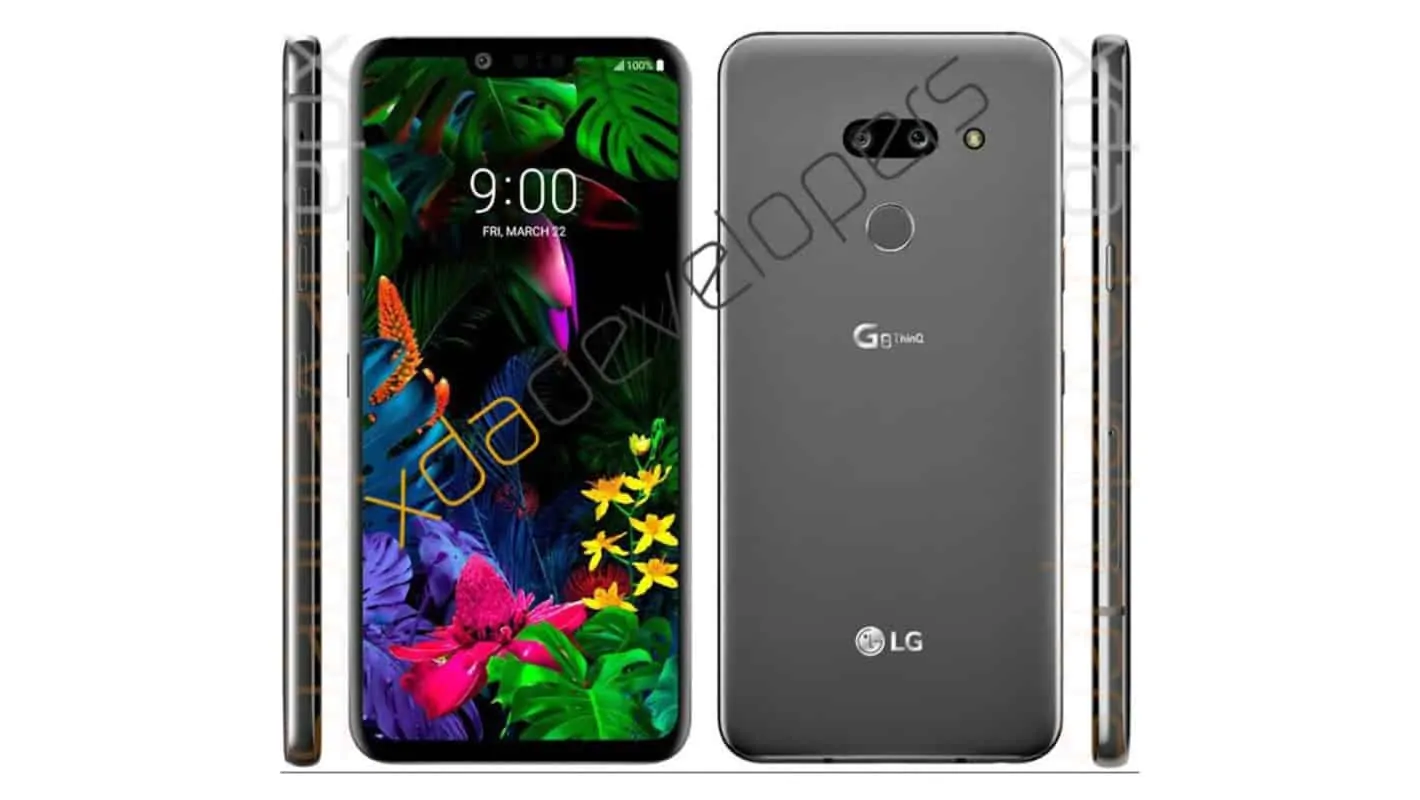This preview will be regularly updated as new information on the LG G8 ThinQ emerges in the run-up to its launch. The last revision was made on February 19.
LG’s G series of Android flagships is still awaiting a true successor to the 2014 G3, a critically acclaimed device with a universal appeal factor. Following half a decade’s worth of experimentation, the South Korean company believes it’s finally on to something and has even confirmed some details about its next high-end Android phablet already.
Given that state of affairs, this certainly looks like the perfect opportunity for a comprehensive recap of everything there is to know about the LG G8 ThinQ so far, as the handset will be hitting the market quicker than you can say “concerning mobile sales,” something the firm is hoping to address with its upcoming product.
What’s official
LG will officially announce the G8 ThinQ as part of its Mobile World Congress 2019 conference, the company said this week. The world’s largest mobile trade show is opening its doors to the general public on February 25 but LG and most other manufacturers will be announcing new products in Barcelona a day earlier.
The Android flagship will offer a massive upgrade in the front-facing camera department as LG equipped it with a time-of-flight (TOF) sensor, a depth-sensing module capable of creating detailed three-dimensional imagery. If that sounds familiar, it’s because the technology has already been around for a while, albeit its consumer-grade applications are only now gaining traction.
The 2017 iPhone X was the first handset to debut with a 3D camera on the front and was followed by the likes of the Xiaomi Mi 8 and the Honor View20. Much like those devices, the LG G8 ThinQ should offer state-of-the-art face unlock support that’s both faster and more accurate (i.e. secure) than conventional authentication solutions based on facial recognition.
In practice, a TOF sensor captures infrared light reflecting off various surfaces, meaning it’s equally reliable in broad daylight and poor lighting conditions. Its more nuanced approach to calculating depth also allows for extremely consistent biometric tech which cannot be tricked with something like a high-resolution photograph of someone’s face.
Instead, contemporary 3D imaging tech works so well that it can even recognize you if you’re wearing glasses, put on a hat, or grow a beard, as evidenced by existing smartphone applications of such solutions.
LG also confirmed the successor to the G7 ThinQ will indeed be advertised as the G8 ThinQ, hence signaling it’s looking to continue its mobile marketing strategy focused on artificial intelligence. Among other things, that plan guarantees the return of a dedicated Google Assistant button on the left edge of the device. The same physical button was part of the G7 ThinQ and has already been spotted in several G8 leaks.
What’s not official but might as well be
Like every single member of this product family, the LG G8 ThinQ should be powered by the latest and greatest system-on-chip from Qualcomm. Right now, that’s the Snapdragon 855 which the American semiconductor giant launched late last year.
While it will definitely be among the first devices to be announced with the Snapdragon 855, the G8 ThinQ’s SoC of choice is likely to see the smartphone’s release pushed back to early April. The first several major batches of Qualcomm’s high-end chipsets are traditionally reserved for the company’s biggest customer – Samsung. In other words, the Galaxy S10 lineup will almost certainly hit the store shelves before LG’s next Android flagship does.
Android 9 Pie is also a given, or at least LG’s proprietary implementation of Google’s operating system is. The last several ultra-premium smartphones from the firm placed a large focus on AI solutions, particularly in the context of mobile photography, and the G8 ThinQ should be no different. Fans of Google-made services should be particularly pleased as the G8 ThinQ’s Google Assistant integration should be on par with the Pixel smartphone range as well and could arguably surpass it given how not even Alphabet’s subsidiary equips its handsets with buttons dedicated to launching its voice companion.
While the latest Android version is much more reliant on gestures, LG is looking to take things a step further, as already indicated by its early G8 ThinQ teasers.
Something old, something new
3D sensors and ultra-powerful chips aside, the G8 ThinQ will still be relatively similar to its predecessor, hence being the first addition to LG’s flagship lineup that’s not looking to radically change its product formula in close to half a decade.
This product family so far ranged from compact flagships to modular devices and everything in between, with those major changes constantly being introduced as part of LG’s efforts to repeat the success of the G3. The fact that the G8 ThinQ will be somewhat similar to the G7 signals the Seoul-based firm concluded it’s happy with its overall design direction after following it for a year – for once.
The new handset will hence make use of a 19:9 image format and a display notch, as well as a high screen-to-body ratio. While most major players in the industry are now moving toward in-screen fingerprint readers, LG appears to have opted for a patient approach on that front as the G8 ThinQ is widely expected to debut with a traditional rear-mounted scanner.
Likewise, the electronics giant doesn’t appear to be convinced by the prospect of triple-lens setups as the G8 ThinQ will feature a more conventional two-camera system on the back, supported by a dual-LED (dual-tone) flash unit. LG’s P-OLED technology should make a return as well, though the overall package is expected to be slightly more rounded than the G7.
Despite being scheduled for an announcement in less than a month, not many sightings of the LG G8 ThinQ emerged online so far. The most credible one yet is essentially identical to a previous leak that LG outright denied being legitimate, breaking with tradition of not commenting on media rumors about its products. The company is expected to launch black and gray variants of the G8 ThinQ which already leaked online, as well as several others.
The next high-end mobile offering from LG should also introduce improvements on the battery front as recent certifications suggest the device will be powered by a 3,400mAh cell, hence surpassing the G7 ThinQ’s capacity by some 400mAh.
Something cost-effective
6GB of RAM and 128GB of storage space are almost a given as well, though it remains to be seen how far will LG go with its memory configurations. 2019 should see the release of multiple handsets with 512GB of flash storage and 8GB of RAM, so the firm might feel compelled to follow suit in order to remain competitive.
At the same time, the lack of a triple-rear camera system and in-display fingerprint reader might hurt the G8 ThinQ’s competitiveness, yet they should also do wonders for LG’s profit margins seeing how both of those functionalities rely on technologies that are still somewhat experimental and hence relatively expensive to implement.
While the presence of a TOF 3D sensor shows LG isn’t steering clear of all new tech, the overall hardware and feature set of the G8 ThinQ suggests the firm is still prioritizing profitability as its mobile sales remain largely flat. That’s part of the reason why the incoming phablet is expected to be priced along the lines of its predecessor which started at approximately $750 outright.
Though the high-end segment of the mobile market isn’t exactly known for value-oriented devices, the G8 ThinQ should fare well on that front relative to the peers that rival it.
Familiar-looking but far from generic
One promising mobile technology that LG is likely to pioneer comes in the form of display-based audio systems and the G8 ThinQ has previously been rumored to feature such a solution. While anything of the sort would allow the firm to improve the screen-to-body ratio of its devices by omitting standard front-facing stereo speakers, LG often used high-end audio reproduction as one of the main selling points of its contemporary handsets and it’s presently unclear whether the tech is already advanced enough to offer a comparable experience based on screen vibrations.
Another potential unique feature of the G8 ThinQ is a second screen, something the company last used for the V20 flagship released in late summer of 2016. However, an alternative display might not be an integral part of the new phablet as recent rumors indicate LG is actually looking to deliver it in the form of an accessory. No other details on the matter emerged so far but looking at the small number of credible G8 ThinQ leaks that are available, such a gadget would almost certainly be paired with the smartphone via a USB Type-C connector.
While 5G will certainly be the mobile marketing buzzword of the year, don’t expect to hear about it in the context of the G8 ThinQ. Instead, LG’s wireless ambitions should manifest themselves in the form of an entirely new range of Android smartphones. The same holds true for the firm’s plans to commercialize foldable handsets, which is something it intends to do this year.
In overall, the LG G8 ThinQ may end up being a familiar-looking Android device but it should also be far from generic, though only time will tell whether that’s enough for LG to revive its troubled mobile division which continues to underperform even as most other parts of the conglomerate are thriving, as revealed by the firm’s recent financial reports.


